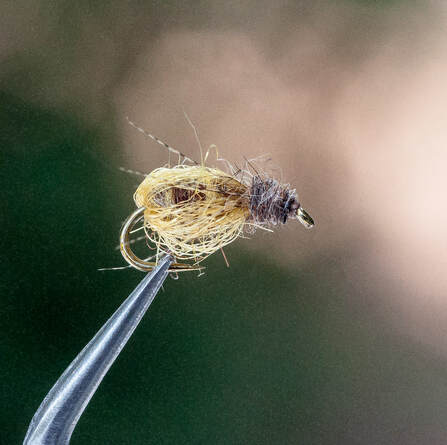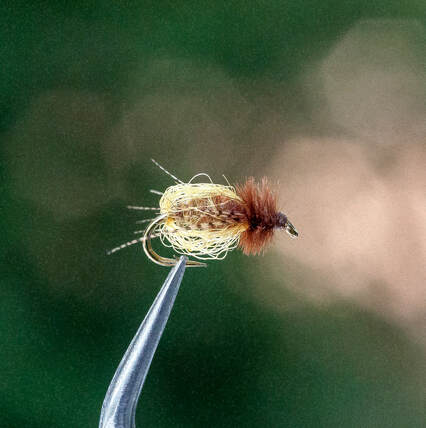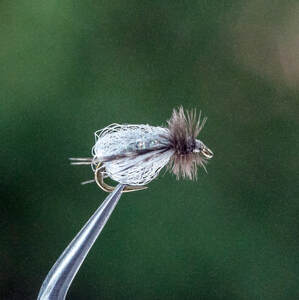Fly of the Month
For decades, I never understood the significance of tying a sparkle dun. Why not a regular dun or comparadun? Then one day I absolutely could not get a trout to take my proven Sulphur dun on the South Holston. Dr. John Benbow gave me a sparkle dun and bam…take after take. What was special about the sparkle dun, the bushy Antron or Z-Lon tail which represented the shuck or casing that was stuck to the dun, essentially a crippled dun. The trout were turned on to the duns that were struggling, not the duns that were successfully emerging and eventually flying away. However, this article is not about the sparkle dun but rather the sparkle and the inventor. Maybe the sparkle dun can be a future fly of the month. This article is about sparkle and the material used. It’s about the genius of using such material.
Gary LaFontaine was a fly fisher much like Albert Einstein was a mathematician, both were considered to be a genius. In 1996, Gary LaFontaine was named Angler of the Year by Fly Rod & Reel magazine. He grew up in Connecticut. He caught his first fish on a fly at age eight and published his first fishing article at age 15. He attended the University of Montana in the early 1960s majoring in behavioral psychology. He arranged his class schedule around the hatches on the Clark Fork River – now that’s genius for sure. He returned to Connecticut where he and his wife did pioneering work preparing mentally retarded children to become self-sufficient. He moved back to Montana in 1973, eventually taking a job in the children’s ward at the State Hospital and also worked as a guide on area rivers. He earned national recognition in 1981 for his second book, Caddisflies, a book combining entomology, years of underwater observation of trout and insect behavior, and new flytying materials and techniques. In 1990, after writing many more fishing related books, Gary LaFontaine in his mid-40s won the Arnold Gingrich Memorial Award for Lifetime Writing Achievements. Sadly, we lost our fly fisher genius, Gary LaFontaine to Amyotrophic lateral sclerosis (ALS) or Lou Gehrig’s disease on January 4, 2002.
Gary LaFontaine’s Deep Sparkle Pupa
As the dog days of summer are here, our fly fishing opportunities change drastically toward terrestrials. However, there is an occasional caddis fly hatch on our wild streams. Through underwater observation, Gary LaFontaine realized something very important. Gary said “When a caddis fly pupa emerges it fills a transparent sheath around its body with air bubbles. These globules of air shimmer and sparkle as they reflect sunlight, creating a highly visible triggering characteristic. This sparkle is the key to imitating the emergent Caddisflies.”
The genius to this fly pattern is the sparkle yarn and the way the “sheath” is tied around the body of the fly. The fly pattern may be fished as a submerged, yet rising pupa much like a soft hackle fly pattern or it may be fished in the surface film with the addition of a floatant gel. The shimmer, the air bubble look and the sparkle make this a go to fly when the caddis hatch is on but the dry caddis fly is not what the trout are taking.
Sparkle Pupa
Fly of the Month 8.14
Deep Sparkle Pupa
Hook: Tiemco 100, size 12,14,16,18
Thread: Uni 8/0 color to match underbody
Weight: Open wraps of lead, note: a heavier hook may be substituted for weight (Tiemco 3769)
Over-Abdomen: Sparkle yarn
Under-Abdomen: Sparkle yarn blend with dubbing (50/50)
Hackle: Ostrich herl, to correspond with underbody or natural dubbing
Legs: Lemon wood duck
Note: There are many variations on this recipe, but, this is tied using Gary LaFontaine’e recipe and instructions from his book, Caddisflies.
- Tom Adams, Alen Baker
Deep Sparkle Caddis Pupa Dub
Deep Sparkle Caddis Pupa Brown
Deep Sparkle Caddis Pupa Yellow
For decades, I never understood the significance of tying a sparkle dun. Why not a regular dun or comparadun? Then one day I absolutely could not get a trout to take my proven Sulphur dun on the South Holston. Dr. John Benbow gave me a sparkle dun and bam…take after take. What was special about the sparkle dun, the bushy Antron or Z-Lon tail which represented the shuck or casing that was stuck to the dun, essentially a crippled dun. The trout were turned on to the duns that were struggling, not the duns that were successfully emerging and eventually flying away. However, this article is not about the sparkle dun but rather the sparkle and the inventor. Maybe the sparkle dun can be a future fly of the month. This article is about sparkle and the material used. It’s about the genius of using such material.
Gary LaFontaine was a fly fisher much like Albert Einstein was a mathematician, both were considered to be a genius. In 1996, Gary LaFontaine was named Angler of the Year by Fly Rod & Reel magazine. He grew up in Connecticut. He caught his first fish on a fly at age eight and published his first fishing article at age 15. He attended the University of Montana in the early 1960s majoring in behavioral psychology. He arranged his class schedule around the hatches on the Clark Fork River – now that’s genius for sure. He returned to Connecticut where he and his wife did pioneering work preparing mentally retarded children to become self-sufficient. He moved back to Montana in 1973, eventually taking a job in the children’s ward at the State Hospital and also worked as a guide on area rivers. He earned national recognition in 1981 for his second book, Caddisflies, a book combining entomology, years of underwater observation of trout and insect behavior, and new flytying materials and techniques. In 1990, after writing many more fishing related books, Gary LaFontaine in his mid-40s won the Arnold Gingrich Memorial Award for Lifetime Writing Achievements. Sadly, we lost our fly fisher genius, Gary LaFontaine to Amyotrophic lateral sclerosis (ALS) or Lou Gehrig’s disease on January 4, 2002.
Gary LaFontaine’s Deep Sparkle Pupa
As the dog days of summer are here, our fly fishing opportunities change drastically toward terrestrials. However, there is an occasional caddis fly hatch on our wild streams. Through underwater observation, Gary LaFontaine realized something very important. Gary said “When a caddis fly pupa emerges it fills a transparent sheath around its body with air bubbles. These globules of air shimmer and sparkle as they reflect sunlight, creating a highly visible triggering characteristic. This sparkle is the key to imitating the emergent Caddisflies.”
The genius to this fly pattern is the sparkle yarn and the way the “sheath” is tied around the body of the fly. The fly pattern may be fished as a submerged, yet rising pupa much like a soft hackle fly pattern or it may be fished in the surface film with the addition of a floatant gel. The shimmer, the air bubble look and the sparkle make this a go to fly when the caddis hatch is on but the dry caddis fly is not what the trout are taking.
Sparkle Pupa
Fly of the Month 8.14
Deep Sparkle Pupa
Hook: Tiemco 100, size 12,14,16,18
Thread: Uni 8/0 color to match underbody
Weight: Open wraps of lead, note: a heavier hook may be substituted for weight (Tiemco 3769)
Over-Abdomen: Sparkle yarn
Under-Abdomen: Sparkle yarn blend with dubbing (50/50)
Hackle: Ostrich herl, to correspond with underbody or natural dubbing
Legs: Lemon wood duck
Note: There are many variations on this recipe, but, this is tied using Gary LaFontaine’e recipe and instructions from his book, Caddisflies.
- Begin by wrapping the hook from the eye to the hook bend with tight touching wraps and let the bobbin hang.
- Cut a three inch piece of sparkle yarn and unravel the four larger cords from each other. Take one cord and using a somewhat fine hair comb (or mustache comb or specialized fly tying comb) and hold one end while stroking through with the comb. There will be resistance for the first several strokes. There will also be fibers pulled loose and that is good. The cord is too thick at first. What is tied is should be “sparse”. On the top of the hook shank, tie in the sparkle yarn, starting at the middle and making sure you keep the yarn on top as you wind thread back to the hook bend. Trim any excess and cut the yarn to about three eyelengths. Keep the waste just cut.
- With a rotating vise, spin the hook upside down. Without a rotary, remove the hook and do the same. Tie in the remaining portion of yarn just as you did on top. When you are finished, take the thread to the hook bend and rotate the fly to normal position, let the bobbin hang.
- Dub the under abdomen with a blend of sparkle yarn and hare’s ear dubbing. Make a traditional cigar shaped body. Let the bobbin hang at the two thirds mark, near the eye where the dubbing stops.
- Select the yarn on the top and bring forward over the dubbing and tie in with two or three loose wraps, making sure to keep the yarn in the top hemisphere. That is, the over body yarn will cover the length of the abdomen and half of the thickness of the abdomen. It looks like a veil, covering, yet open and “wispy”. You can push the yarn back with a thumbnail to create the bubble effect and/or use a bodkin to arrange the yarn fibers as you want. Although covered by the veil of yarn the under abdomen should be visible.
- Repeat the process for the bottom yarn. Tie off both top and bottom securely and trim any waste.
- Select three or four lemon wood duck flank feathers and tie in on each side, extending just to the end of the body.
- Select one ostrich herl and tie in immediately in front of the body and wrap to the eye. Tie off, trim waste, whip finish. Natural dubbing may be substituted for the herl.
- Tom Adams, Alen Baker
Deep Sparkle Caddis Pupa Dub
Deep Sparkle Caddis Pupa Brown
Deep Sparkle Caddis Pupa Yellow
Deep Sparkle Pupa
There are many variations on this recipe, but, this is tied using Gary LaFontaine’e recipe and instructions from his book, Caddisflies.
HOOK : Tiemco 100, size 12,14,16,18
THREAD : Uni 8/0 color to match underbody
WEIGHT : Open wraps of lead, note: a heavier hook may be substituted for weight (Tiemco 3769)
overABDOMEN: Sparkle yarn
under ABDOMEN : Sparkle yarn blend with dubbing (50/50)
HACKLE : Ostrich herl, to correspond with underbody or natural dubbing
LEGS: Lemon wood duck
There are many variations on this recipe, but, this is tied using Gary LaFontaine’e recipe and instructions from his book, Caddisflies.
HOOK : Tiemco 100, size 12,14,16,18
THREAD : Uni 8/0 color to match underbody
WEIGHT : Open wraps of lead, note: a heavier hook may be substituted for weight (Tiemco 3769)
overABDOMEN: Sparkle yarn
under ABDOMEN : Sparkle yarn blend with dubbing (50/50)
HACKLE : Ostrich herl, to correspond with underbody or natural dubbing
LEGS: Lemon wood duck
- Begin by wrapping the hook from the eye to the hook bend with tight touching wraps and let the bobbin hang
- Cut a three inch piece of sparkle yarn and unravel the four larger cords from each other. Take one cord and using a somewhat fine hair comb (or mustache comb or specialized fly tying comb) and hold one end while stroking through with the comb. There will be resistance for the first several strokes. There will also be fibers pulled loose and that is good. The cord is too thick at first. What is tied is should be “sparse”. On the top of the hook shank, tie in the sparkle yarn, starting at the middle and making sure you keep the yarn on top as you wind thread back to the hook bend. Trim any excess and cut the yarn to about three eyelengths. Keep the waste just cut.
- With a rotating vise, spin the hook upside down. Without a rotary, remove the hook and do the same. Tie in the remaining portion of yarn just as you did on top. When you are finished, take the thread to the hook bend and rotate the fly to normal position, let the bobbin hang
- Dub the under abdomen with a blend of sparkle yarn and hare’s ear dubbing. Make a traditional cigar shaped body. Let the bobbin hang at the two thirds mark, near the eye where the dubbing stops.
- Select the yarn on the top and bring forward over the dubbing and tie in with two or three loose wraps, making sure to keep the yarn in the top hemisphere. That is, the over body yarn will cover the length of the abdomen and half of the thickness of the abdomen. It looks like a veil, covering, yet open and “wispy”. You can push the yarn back with a thumbnail to create the bubble effect and/or use a bodkin to arrange the yarn fibers as you want. Although covered by the veil of yarn the under abdomen should be visible.
- Repeat the process for the bottom yarn. Tie off both top and bottom securely and trim any waste.
- Select three or four lemon wood duck flank feathers and tie in on each side, extending just to the end of the body.
- Select one ostrich herl and tie in immediately in front of the body and wrap to the eye. Tie off, trim waste, whip finish. Natural dubbing may be substituted for the herl.



